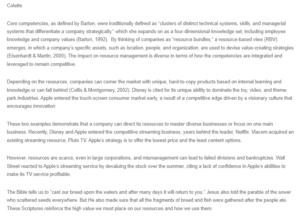Response – Leadership and Culture in Innovation: Apple and Netflix
Collete,
Great post! I agree with you that traditionally, core competencies composed of technical skills and structures that uniquely differentiated a company by granting it’s a strategic niche. I also concur with you that the resource-based strategy is based on creating value from the firm’s assets, for instance, human resources or technological investments.
I think you ought to be more specific on resources determining market leadership. In the event of adequate finances but the absence of innovation and product development, a firm would not gain a competitive edge. Finances are quite essential but are ineffective on their own. Therefore, other factors such as knowledge, organizational culture, innovation, and information exchange come into play. The firm’s long-term viability stems from the dynamics of the mentioned aspects.
From my research, I think leadership plays a crucial role in a firm’s innovation and growth, in addition to the availability of resources. Management innovation depends on the leaders’ attitudes, beliefs and objectives. A company endowed with all the resources required and exhibiting poor leadership is least likely to innovate. I loved the examples you gave of Apple and Netflix. These two firms contain a strong organizational culture based on innovation and continuous improvement. Apple had grown under Steve Jobs’s leadership till 2011 when he met his death Heracleous & Papachroni (2016). During his tenure, Jobs initiated a series of innovations that included the iPad, iPhone, iPod, and Mac. Apple’s success in innovation and development was partly due to the potent leadership behind the wheel. Similarly, Netflix initially started as a video leasing firm before it ventured into streamlining Guenther & Rothaermel. (2017). The leaders behind Netflix Inc. are continually innovating to the extent the firm beat its biggest competitor, Blockbuster.
References
Guenther. A & Rothaermel. F .(2017).Netflix Inc. McGraw-Hill Education.
Heracleous, L., & Papachroni, A. (2016). Strategic Leadership and Innovation at Apple Inc.
ORDER A PLAGIARISM-FREE PAPER HERE
We’ll write everything from scratch
Question
Colette
Core competencies, as defined by Barton, were traditionally defined as “clusters of distinct technical systems, skills, and managerial systems that differentiate a company strategically,” which she expands on as a four-dimensional knowledge set, including employee knowledge and company values (Barton, 1992). By thinking of companies as “resource bundles,” a resource-based view (RBV) emerges, in which a company’s specific assets, such as location, people, and organization, are used to devise value-creating strategies (Eisenhardt & Martin, 2000). The impact on resource management is diverse in terms of how the competencies are integrated and leveraged to remain competitive.

Response – Leadership and Culture in Innovation
Depending on the resources, companies can corner the market with unique, hard-to-copy products based on internal learning and knowledge or can fall behind (Collis & Montgomery, 2002). Disney is cited for its unique ability to dominate the toy, video, and theme park industries. Apple entered the touch-screen consumer market early, a result of a competitive edge driven by a visionary culture that encourages innovation.
These two examples demonstrate that a company can direct its resources to master diverse businesses or focus on one main business. Recently, Disney and Apple entered the competitive streaming business, years behind the leader, Netflix. Viacom acquired an existing streaming resource, Pluto TV. Apple’s strategy is to offer the lowest price and the least content options.
However, resources are scarce, even in large corporations, and mismanagement can lead to failed divisions and bankruptcies. Wall Street reacted to Apple’s streaming service by devaluing the stock over the summer, citing a lack of confidence in Apple’s abilities to make its TV service profitable.
The Bible tells us to “cast our bread upon the waters and after many days it will return to you.” Jesus also told the parable of the sower who scattered seeds everywhere. But He also made sure that all the fragments of bread and fish were gathered after the people ate. These Scriptures reinforce the high value we must place on our resources and how we use them.
References
Collis, D.J. & Montgomery, C.A. (1995). Competing on resources. Harvard Business Review.
Low, E., Spangler, T., Low, E., & Spangler, T. (2019, September 17). Explosion of Streaming Services Points to Price Wars on the Horizon. Retrieved October 2, 2019, from https://variety.com/2019/digital/features/streaming-services-prices-apple-tv-plus-disney-netflix-hbo-max-1203338028/.
Meyer, P. (2019, February 15). Apple Inc.’s Organizational Culture & Its Characteristics (An Analysis). Retrieved October 2, 2019, from http://panmore.com/apple-inc-organizational-culture-features-implications.
Prahalad, C.K. & Hamel, G. (1990). The core competence of the corporation. Harvard Business Review.

